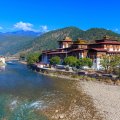PUNAKHA DZONG
Go there and contact
The most beautiful fortress with a suspension bridge, housing a 100-pillar hall with walls decorated with frescoes depicting the life of Buddha
It is one of the most beautiful fortresses of the country. Built in 1637, by the Shabdrung Ngawang Nmgyal, at the confluence of two rivers, the Pho Chu and the Mo Chu (the father and the mother), the Punakha dzong has long constituted the town on its own. Until the 1950s, it served as the capital and seat of government. Several times damaged by fires and earthquakes, the dzong has been rebuilt many times, as has the suspension bridge that connects it to the village. A flight of very steep steps leads under its porch. On its walls have been painted the guardians of the four directions, the symbol of the Kalachakra and a poem dedicated to the Shabdung. In the first courtyard, a huge chörten was built in 1981, next to a magnificent pipal, the tree under which the Buddha attained Enlightenment. Behind the central tower, two other courtyards follow one another. In the last one, a temple contains the relics of the Shabdung, who died in this dzong. One then reaches the famous 100-pillar hall whose walls are decorated with frescoes depicting the life of Buddha. Majestic, three enormous gold statues of Buddha, Guru Rinpoche and Shabdrung date from the 18th century.
Occupying a strategic site that dominates the three valleys, the dzong is said to have been built by order of Shabdung, following a premonitory dream. This dzong is the only one to have kept its shingle roofs, and the second courtyard, that of the monks, is very narrow and connects the first by a bridge which gives it its character of a fortified castle.
Did you know? This review was written by our professional authors.
Book the Best Activities with Get Your Guide
Members' reviews on PUNAKHA DZONG
The ratings and reviews below reflect the subjective opinions of members and not the opinion of The Little Witty.


